What is a Value Chain?
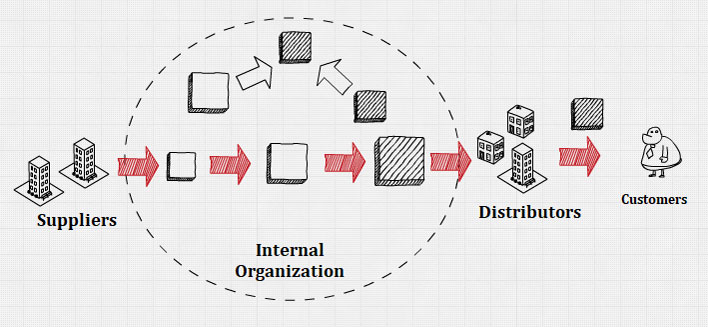
Value chain refers to the idea that a company is a chain of activities for transforming inputs into outputs valued by customers’ value.
A value chain is a set of value-creating activities that begin with basic raw materials coming from suppliers, moving on to a series of value-added activities involved in producing and marketing a product or service, and ending with distributors getting the final goods into the hands of the ultimate consumer.
A value chain charts the path by which products and services are created and eventually sold to customers. The term value chain reflects the fact that, as each step of this path is completed, the product becomes more valuable than it was at the previous step.
Firms must study their value chain to understand their cost position associated with organizational activities, from purchasing raw materials to manufacturing products, and to market those products.
Firms must study their value chain to identify their capabilities and core competencies. When using their unique core competencies to create unique value for customers that competitors cannot duplicate, firms have established one or more competitive advantages.
These are the means that can be used to facilitate the implementation of a chosen strategy.
In a value chain, total revenues minus total costs of all activities undertaken to develop and market a product or service yields value.
Understanding this concept is important because the firm earns above-average returns only when the value it creates is greater than the costs incurred to create that value.
In other words, the combined costs of all the various activities in a company’s value chain define the firm’s cost of doing business. A firm will be profitable as long as total revenues exceed the total costs incurred in creating and delivering the product or service.
There can be more than a hundred particular value-creating activities associated with the business of producing and marketing a product or service, and each one of the activities can represent a competitive advantage or disadvantage for the firm.
All firms in a given industry have a similar value chain.
These value chains may include activities such as obtaining raw materials, designing products, building manufacturing facilities, developing cooperative agreements, and providing customer service.
Value chains differ immensely across industries and firms.
Firms should strive to understand not only their own value chain operations but also their competitors’, suppliers’, and distributors’ value chains.
However, all firms should understand the value chain to develop and nurture a core competence and convert this competence into a distinctive competence. Core competence is a value chain activity that a firm performs especially well. When a core competence gives a firm a superior value comparing to its rivals, then it is called a distinctive competence.
Firms should determine where cost advantages and disadvantages in their value chain occur relative to the value chain of rival firms.
This benchmarking process entails measuring costs of value chain activities across industries to determine best practices among competing firms for the purpose of duplicating or improving upon those best practices.
Benchmarking enables a firm to take action to improve its competitiveness by identifying (and improving upon) value chain activities where rival firms have comparative advantages in cost, service, reputation, or operation.
The hardest part of benchmarking can be gaining access to other firms’ value chain activities with associated costs.
Typical sources of benchmarking information include published reports, trade publications, suppliers, distributors, customers, partners, creditors, shareholders, lobbyists, and willing rival firms.
Value Chain Analysis (VCA)
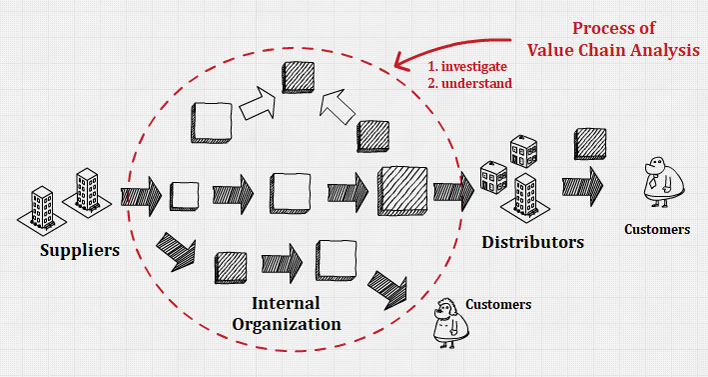
Value chain analysis (VCA) is a process that allows the firm to study and understand the parts of its operations that create value and those that do not.
VCA aims to analyze the overall chain of value-creating activities and identify where low-cost advantages or disadvantages exist anywhere along the value chain from raw material to customer service activities.
VCA can be critically important for a firm in monitoring whether its prices and costs are competitive. When a major competitor or new market entrant offers products or services at very low prices, this may be because that firm has substantially lower value chain costs, or perhaps the rival firm is just waging a desperate attempt to gain sales or market share.
Thus, VCA can enable a firm to better identify its own strengths and weaknesses, especially as compared to competitors’ value chain analyses and their own data examined over time.
The process of implementing value chain analysis would require several steps.
The initial step in implementing this procedure is to divide a firm’s operations into specific activities or business processes.
The second step is that the firm attempts to attach a cost to each discrete activity, with the costs could be in terms of both time and money.
The last step is where the firm converts the cost data into information by looking for competitive cost strengths and weaknesses that may yield competitive advantage or disadvantage.
Completing activities of the value chain often requires building effective alliances with suppliers, sometimes others to which the firm outsources activities, and developing strong positive relationships with customers.
Outsourcing is an effective solution to consider when its resources and capabilities are not a source of core competence.
When firms have strong positive relationships with suppliers and customers, they are said to have social capital. The relationships themselves have value because they lead to transfers of knowledge as well as access to resources that a firm may not hold internally.
To build social capital whereby resources such as knowledge are transferred across organizations requires trust between partners. Indeed, partners must trust each other in order to allow their resources to be used in such a way that both parties will benefit over time while neither party will take advantage of the other.
Evaluating a firm’s capability to execute its value chain activities and support functions are challenging and requiring substantial judgment.
Substantial judgment may be required in performing a VCA because no obviously correct model or rule is universally available to help in the process.
Substantial judgment may be required partially because different activities along the value chain may impact other items positively or negatively. Thus, there exists a complex interrelationship between these activities. Cost and price differences among rival firms can have their origins in activities performed by suppliers, distributors, creditors, or even shareholders.
Industry Value Chain
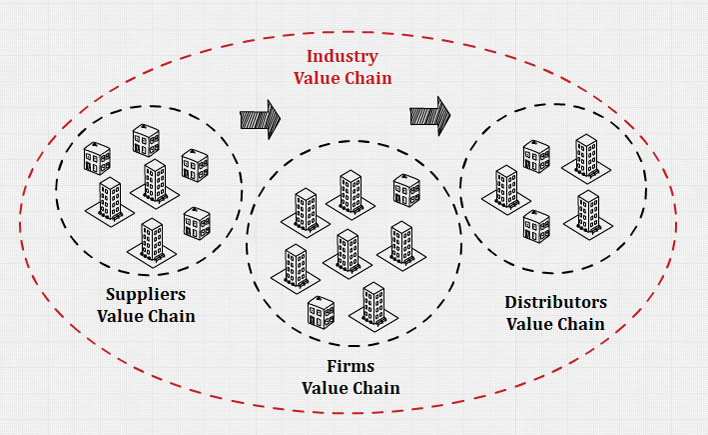
An industry can be analyzed in terms of profit margin at any point along the value chain. The revenues and products are divided among many value chain activities.
In analyzing the complete value chain of a product, even if a firm operates up and down the entire industry chain, it usually has an area of expertise where its primary activities lie.
This is the center of gravity of the organization in the value chain. It is important to the firm as this is where expertise and capabilities, and core competencies lie.
Value chains in most industries can be decomposed into two segments, upstream and downstream segments.
In other words, after the organization has established within the industry with its competitive advantage, it will move forward and backward along the value chain in order to reduce costs, gain access to key materials, and guarantee distribution.
Corporate Value Chain
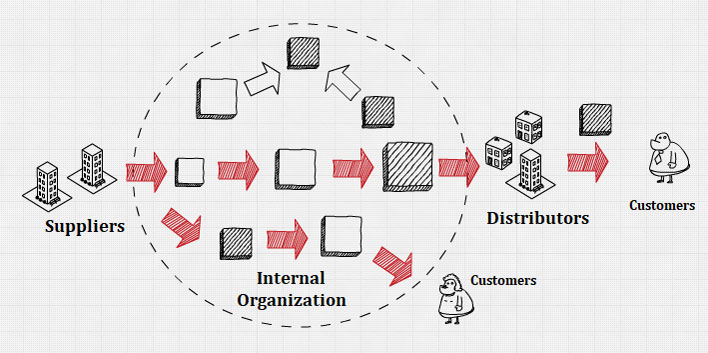
A corporate value chain is an internal value chain of activities.
The firms’ primary activities usually begin with inbound logistics (raw material and warehousing), go through operation processes in which a product is manufactured, and continue on to outbound logistics (warehousing and distribution), to marketing and sales, and finally to service (installation, repair, and sale of parts).
Support activities, such as procurement, technology development, human resource management, and firm infrastructure (accounting, finance, strategic planning), ensure that the primary value chain activities operate effectively and efficiently.
Each product line in the organization has its own distinctive value chain.
Because each firm has several products and services, an internal analysis of the firm involves analyzing a series of different value chains.
Understanding each individual activity along the value chain will give insight into the organization’s resources, capabilities, core competencies, hence its strengths and weaknesses.
Corporate value chain analysis involves 3 steps.
The first step is to examine each product line value chain in terms of the various activities involved in producing that product or service. Which activities can be considered strengths (core competencies), or weaknesses (core deficiencies)?
The second step is to examine the linkages within each product line value chain. Linkages are the connections between the way one value activity is performed and the cost of performance of another activity.
The third step is to examine the potential synergies among the value chains of different product lines or business units. Each value element, such as advertising or manufacturing, has an inherent economy of scale in which activities are conducted at their lowest possible cost per unit.
If a particular product is not being produced at a sufficient level to reach economies of scale in distribution, another product could be used to share the same distribution channel. The cost of joint production of multiple products can be lower than the cost of separate production.
Elements of the Value Chain
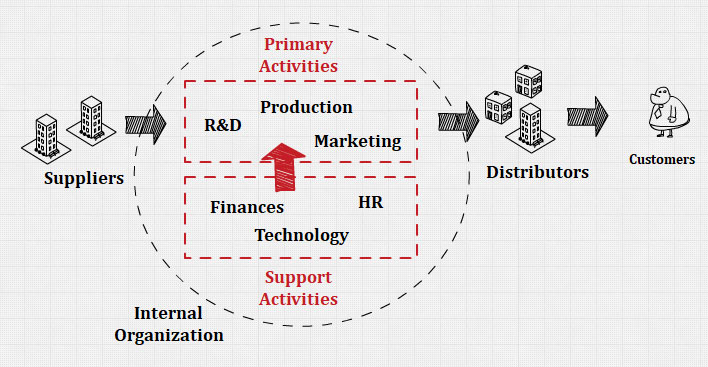
A value chain of a firm is segmented into (1) value chain primary activities and (2) value chain support activities.
Value chain primary activities are direct activities the firm completes in order to produce products and then sell, distribute, and service those products in ways that create value for customers.
Value chain support activities include the activities the firm completes in order to support the work being done to produce, sell, distribute, and service the products the firm is producing.
A firm can develop a capability in any of the value chain primary or support activities. When it does so, it has established a competence to create value for customers.
Primary Activities
Primary activities have to do with the design, creation, delivery of the product, marketing, and its support and after-sales service.
There are 5 primary activities: (1) Inbound logistics refers to the arrival of raw materials; (2) Operations refers to the actual production process; (3) Outbound logistics tracks the movement of a finished product to customers (4) Marketing and sales deals with attracting potential customers and convincing them to make purchases; (5) Customer service refers to the extent to which a firm provides assistance to their customers.
The 5 primary activities are broken down into 4 functions: research and development, production, marketing and sales, and customer service.
Research and Development
Research and development (R&D) are concerned with the design of products and production processes.
Although we think of R&D as being associated with the design of physical products and production processes in manufacturing enterprises, many service companies also undertake R&D.
The R&D function can help to (1) lower costs or raise the value of a product and (2) permit a company to charge higher prices.
By superior product design, R&D can increase the functionality of products, which makes them more attractive to customers, thereby adding value.
Alternatively, the work of R&D may result in more efficient production processes, thereby lowering production costs.
Production
Production is concerned with the creation of a good or service.
For physical products, production generally means manufacturing. For services such as banking or retail operations, production typically takes place when the service is delivered to the customer.
By performing its activities efficiently, the production function of a company (1) helps to lower its cost structure, and (2) performs its activities in a way that is consistent with high product quality, which leads to differentiation, higher value, and lower costs.
Marketing and Sales
There are several ways in which the marketing and sales functions of a company can help to create value.
Marketing and sales can add value through brand positioning and advertising.
The marketing function can increase the value that customers perceive to be contained in a company’s product, and thus the utility they attribute to the product. Insofar as this helps to create a favorable impression of the company’s product in the minds of customers, they increase perceived value.
Marketing and sales can also create value by discovering customer needs.
These needs can then be communicated back to the R&D function of the company, which can then design products that better match those needs.
Customer Service
The role of the service function of an enterprise is to provide after-sales service and support.
This function can create superior utility by solving customer problems and supporting customers after they have purchased the product.
Support Activities
Support activities of the value chain provide inputs that allow the primary activities to take place. These activities are not directly involved in the evolution of a product but instead provide important underlying support for primary activities.
There are several major activities: (1) Firm infrastructure refers to how the firm is organized and led by executives; (2) Human resource management, which involves the recruitment, training, and compensation of employees; (3) Technology refers to the use of computerization and telecommunications to support primary activities; (4) Procurement is the process of negotiating for and purchasing raw materials.
These activities are broken down into 4 functions: materials management or logistics, human resources, information systems, and company infrastructure.
Logistics (Material Management)
The logistics function controls the transmission of physical materials through the value chain, from procurement through production and into distribution.
The efficiency with which this is carried out can significantly lower costs, thereby creating more value. Lower inventories mean lower costs and hence greater value creation.
Human Resources
This function ensures that the company has the right mix of skilled people to perform its value-creation activities effectively.
It is also the job of the human resource function to ensure that people are adequately trained, motivated, and compensated to perform their value-creation tasks.
If the human resources are functioning well, employee productivity rises (which lowers costs) and customer service improves (which raises utility), thereby enabling the company to create more value.
Information Systems
Information systems refer largely to the electronic systems for managing inventory, tracking sales, pricing products, selling products, dealing with customer service inquiries, and so on.
Information systems, when coupled with the communications features of the Internet, are holding out the promise of being able to improve the efficiency and effectiveness with which a company manages its other value-creation activities.
Company Infrastructure
Company infrastructure is the companywide context within which all the other value creation activities take place: the organizational structure, control systems, and company culture.
Because top management can exert considerable influence in shaping these aspects of a company, top management should also be viewed as part of the infrastructure of a company.
Indeed, through strong leadership, top management can shape the infrastructure of a company and, through that, the performance of all other value-creation activities that take place within it.
From Value Chain to Supply Chain

A supply chain is a system of people, activities, information, and resources involved in creating a product and moving it to the customer.
Creating supply chains requires 4 components.
Component 1: Strategic supply chain management
Strategic supply chain management is the use of supply chains as a means to create competitive advantages and enhance firm performance.
Such an approach contradicts the popular wisdom centered on the need to maximize speed. Instead, there is recognition that the fastest chain may not satisfy customers’ needs.
Best value supply chains strive to excel along 4 measures: (1) Speed or Cycle time is the time duration from initiation to completion of the production and distribution process; (2) Quality refers to the relative reliability of supply chain activities; (3) Supply chains’ efforts at managing cost involve enhancing value by either reducing expenses or increasing customer benefits for the same cost level; (4) Flexibility refers to a supply chain’s responsiveness to changes in customers’ needs.
By balancing these four metrics, best value supply chains attempt to provide the highest level of total added value.
Component 2: Agility
Agility is the supply chain’s relative capacity to act rapidly in response to dramatic changes in supply and demand.
Agility can be achieved using buffers.
Excess capacity, inventory, and management information systems all provide buffers that better enable the best value supply chain to service and to be more responsive to its customers.
Rapid improvements and decreased costs in deploying information systems have enabled supply chains to reduce inventory as a buffer.
Much popular thinking depicts inventory reduction as a goal in and of itself. However, this cannot occur without corresponding increases in buffer capacity elsewhere in the chain, or performance will suffer.
The best value supply chain seeks to optimize the total costs of all buffers used. The costs of deploying each buffer differ across industries. Therefore, no solution that works for one company can be directly applied to another in a different industry without adaptation.
Agility in a supply chain can also be improved and achieved by colocating with the customer. This arrangement creates an information flow that cannot be duplicated through other methods.
Daily face-to-face contact for supply chain personnel enables quicker response times to customer demands due to the speed at which information can travel back and forth between the parties.
Again, this buffer of increased and improved information flows comes at an expense, so firms seeking to build the best value supply chain will investigate the opportunity and determine whether this action optimizes total costs.
Component 3: Adaptability
Adaptability refers to a willingness and capacity to reshape supply chains when necessary.
Generally, creating one supply chain for a customer is desired because this helps minimize costs. Adaptable firms realize that this is not always the best value solution, however.
In situations in which the interests of one firm in the chain and the chain as a whole conflict, most firms will choose an option that benefits themselves.
This creates a need for alignment among chain members.
Component 4: Alignment
Alignment refers to creating consistency in the interests of all participants in a supply chain.
In many situations, this can be accomplished through carefully writing incentives into contracts.
Collaborative forecasting with suppliers and customers can also help build alignment. Taking the time to sit together with participants in the supply chain to agree on anticipated business levels permits shared understanding and rapid information transfers between parties. This is particularly valuable when customer demand is uncertain, such as in the retail industry.
Resources
Further Reading
- Value Chain (investopedia.com)
- What is a Value Chain Analysis (online.hbs.edu)
- Porter’s Value Chain (ifm.eng.cam.ac.uk)
- Value Chain Analysis (strategicmanagementinsight.com)
- Value Chain Analysis Modeling (cbxsoftware.com)
- Supply Chain (investopedia.com)
- What is a Supply Chain (cips.org)
- What is Supply Chain Management and Why is it Important? (riverlogic.com)
- What is a Value Chain? (corporatefinanceinstitute.com)
Even More Reading
- A Simple Guide to Value Chain Analysis: How to Build More Efficient Sales Processes (pipedrive.com)
- What Is Industry Value Chain Analysis? (blog.marketresearch.com)
Related Concepts
References
- Mastering Strategic Management. (2016, January 18). Open Textbooks for Hong Kong.
- Wheelen, T. L. (2021). Strategic Management and Business Policy: Toward Global Sustainability 13th (thirteenth) edition Text Only. Prentice Hall.